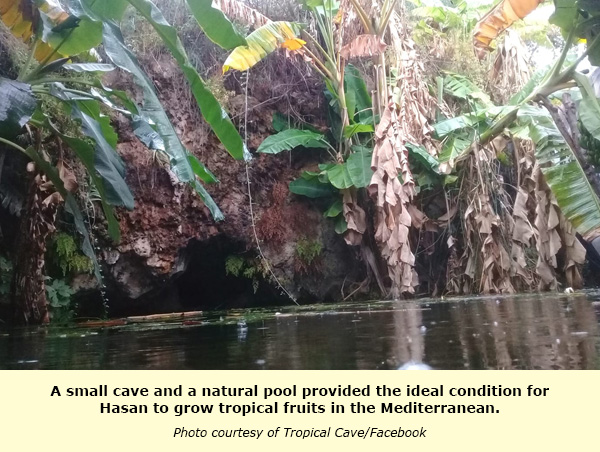The idea of creating a tropical cave appeared in a flash to a journalist from Tartus city, Syria in 2013. Hasan, is a passionate journalist and photographer, whose job led him to places in Syria where tropical plants were planted anyhow and all over the place but not properly looked after. Hasan, who has agricultural experience and knowledge and owns land in the Tartus countryside, an area conducive to tropical plants, realized he had a place which would pave the way for his idea to see the light.
His idea was to cultivate tropical plants in the Mediterranean, which is a great challenge, but Hassan’s passion for adventure led him to try despite the difficult environment and Syria’s political situation. The result is Hasan’s “Tropical Cave”, agricultural land surrounded by a pool and with a small cave after which the project is named.

Difficulties, Patience and Support
Hasan planted tropical fruits by hand in 2013 and 75% of the plants died due to frost and poor weather conditions but Hasan kept trying and planting over and over again until 2018 when results started to emerge. “About 93 tropical species”, said Hasan. “A lot of them died and I renewed planting them and still some are difficult to grow because it is not their original environment,” he added.
Because of the failed attempts Hasan got depressed but he has always been able to motivate himself to keep trying. The internet has been the main source for Hasan to learn about fruits and the way they are planted as well as Syrian expatriates who helped him with their knowledge, providing him with seeds and advice for which Hasan is very grateful.
When asked about his passion, Hassan told 7D News, “the sense of beauty when you plant a tree and watch its flowers and fruits grow is a priceless feeling, and people’s interaction with that is great”. For Hasan, this experience has been an adventure which turned out to be fruitful.
The emergence of the desired results in 2018 and 2019 aroused people’s curiosity and they started coming to see the fruits and be introduced by Hasan to this unique type of experience and they were amazed. “I started to introduce people to this new agriculture experience and teach them the fruit types and their benefits and how to use, consume and plant them.” Hasan explained.
The Variety of Tropical Fruits
This modest land has witnessed repeated efforts to grow different types of tropical fruit, such as papaya, which has risen from 40 to 100 fruits in the space of two years. It can be used in cocktails and fruit salads, which are served in a small café in the Tropical Cave. Dragon Fruit, Lychee, carambola, Pepino, guava, mango, Annona, prickly pear, Sapote, inca berry, physalis Peruviana, sugar apple and many other fruits have been introduced to the Syrian people in the Tropical Cave to great public interest.
Different types of bananas can be found in beautiful different colours such as plantano bananas (plantains), which do not contain sugar and, as Hassan explained with enthusiasm. “it can be fried when green. When it becomes pinkly yellow it tastes delicious and when it is crusty, the banana can be turned into a delicious dessert by grilling it for about 15 minutes to bring out its flavour.”
Hasan is working on creating more features in his tropical cave. He is working on a tropical fish pool, surrounded by tropical plants and more enhancements as well as continuously trying new kinds of fruit.
Spreading the Word to the Community and Farmers
People started coming from all over Syria to visit and learn about the fruits, and in the nice simple tropical café next to the cave and water they can enjoy the new cocktails and fruit salads from this heavenly garden.
Hasan started introducing farmers to how these fruits can be grown and they have started planting them. In cooperation with the Tropical Cave, about 11 farms have started planting tropical fruits and provide the cave with their produce. Hasan comments, “I introduced farmers to the fruits and provided them with simple studies and explained to them that this might be a substitute project for some traditional crops that might be unproductive financially.”
Hasan has started taking part in exhibitions like the “Made in Syria” exhibition in Aleppo to communicate his ideas to a wider audience and to encourage new ways to improve local production after his many attempts.
In addition, Hasan shares everything with people on social media, showing them the trees and explaining everything about every kind of fruit. He even shares his failures and keeps people updated with all the details of his tropical cave.
Source: Marah Sharba, 7D News
